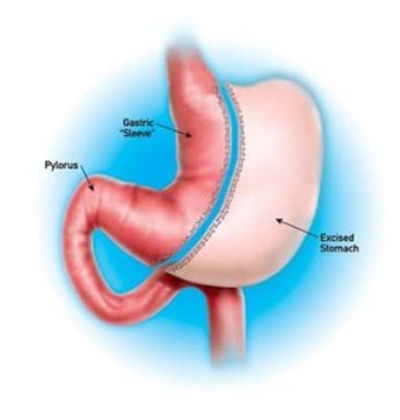WEIGHT LOSS SURGERY
All Surgeries Are Performed with Laparoscopic Technique

ROUX EN-Y GASTRIC BYPASS SURGERY
The factors that determine the best possible surgery for you are your age, medical history, EGD, and psychological and dietary evaluations.
We inform, we recommend, you choose.
All procedures are performed with laparoscopic technique.
The Roux-en Y Gastric Bypass procedure involves creating a restrictive 45 cc stomach pouch out of a small portion of the stomach and attaching it directly to the small intestine bypassing a large part of the stomach and duodenum.
This creates a smaller capacity for food intake in the stomach. The duodenum is bypassed which causes reduction of fat absorption.
This procedure has the positive effect of increasing pYY and GLP1 hormones, and decreasing ghrelin.
Complications can include nausea, vomiting, and "dumping."
It is important to change life-style habits, join support group, take the recommended vitamins, and continue education after surgery.
This operation cures 80% of gastric bypass patients' diabetes. Hypertension patients experience a 60% cure rate. Acid reflux patients experience a 99% cure rate.
Weight loss after one year is 75% and after 5 years is 60% of EBWL.
A one to two day hospital stay can be expected.

GASTRIC SLEEVE
The factors that determine the best possible surgery for you are your age, medical history, EGD, and psychological and dietary evaluations.
We inform, we recommend, you choose.
In the laparoscopic sleeve gastrectomy procedure, a portion of the stomach is detached, creating a banana shaped pouch, and the stomach is then closed into a 110 cc pouch. This creates a smaller capacity for food intake in the stomach.
The sleeve gastrectomy may be converted to a gastric bypass or Duodenal Switch at a later date.
The sleeve has the positive effect of increasing pYY and GLP1 hormones, and decreasing ghrelin.
Complications can include nausea and vomiting due to over eating or eating too quickly.
It is important to change life-style habits, join support group, take the recommended vitamins, and continue education after surgery.
This procedure is a superior weight loss tool to the lap band in a prospective study.
It cures 50-60% of diabetes. Hypertension cure is 50-60%
Weight loss after 1 year is 60%; and 5 years is 50% of EBWL.
People with smaller BMI rates typically do better with this procedure. It is a safe "bridge procedure" for high BMI patients.
There is a low complication rate even with high risk patients.
An over night hospital stay can be expected.

BILIOPANCREATIC DIVERSION
WITH DUODENAL SWITCH
The factors that determine the best possible surgery for you are your age, medical history, EGD, and psychological and dietary evaluations.
We inform, we recommend, you choose.
The Duodenal Switch involves reducing the stomach to a restrictive 110 cc pouch, similar to the gastric sleeve.
A small portion of the duodenum (or the first part of the small intestines) is kept in the digestive system. The small intestines and the flow of food is separated from the flow of bile and pancreatic juices. The food and digestive juices interact only in the last 100 cm of the intestines.
The procedure has a positive effect of increasing PYY, and GLP1 hormones, and decreasing the hormone ghrelin.
Complications can include nausea, vomiting, and more frequent bowel movements.
It is important to change life-style habits, join support group, take the recommended vitamins, and continue education after surgery. At one year, patients can expect to have lost 80% of their excess weight.




